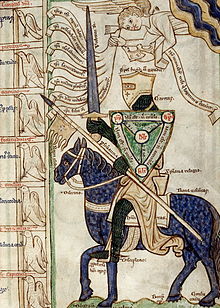
Back Soldat de Crist Catalan Miles christianus German Caballero cristiano Spanish سربازان مسیحی Persian Miles Christianus ID
This article needs additional citations for verification. (May 2013) |


The miles Christianus (Christian soldier) or miles Christi (soldier of Christ) is a Christian allegory based on New Testament military metaphors, especially the Armor of God metaphor of military equipment standing for Christian virtues[1] and on certain passages of the Old Testament from the Latin Vulgate.[2] The plural of Latin miles (soldier) is milites or the collective militia.[3]
By the 5th century, the Church had started to develop doctrines that allowed for Christian participation in battle, though this was limited by a requirement that the fighting must be undertaken to convert infidels or spread the glory of Christ. Christians were not to fight for conquest or personal glory.[4]
- ^ Ephesians 6:14–17
- ^ Job 7:1 (Vulgate): Militia est vita hominis super terram...
- ^ Brian A. Catlos, "Militia Christi", Oxford Dictionary of the Middle Ages (Oxford, 2010), defines militia Christi as the "idea of service to the church, with military connotations derived from crusading ideology and Bernard of Clairvaux's writings."
- ^ Iwanczak, Wojciech (2012). "Miles Christi: the medieval ideal of knighthood". Journal of the Australian Early Medieval Association. 8 (Journal Article): 77–. ISSN 1449-9320.